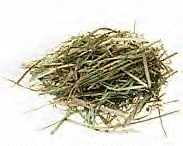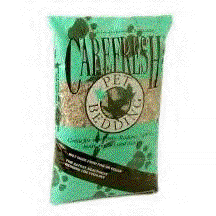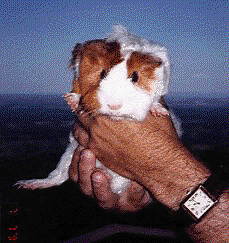
*Note: For a printer-friendly
version of this article, click here*
Varieties
The 1996-2000 American Cavy (guinea pig)
Breeders Association lists 12 recognized breeds of guinea pigs.
This includes smooth coated, long coated, frizzy coated, rosetted
(one or many) coats, and extra shiny breeds. Show guinea pigs
are accepted in nine solid colors - black, white, chocolate,
red, beige, cream, red-eyed orange, blue, and lilac. There are
also many accepted combinations and patterns of these colors.
Mixed breeds make equally as wonderful pets, and are just as
interesting and uniquely beautiful.
Adult Size/Weight and
Life Span
Length is approximately 6-7", roughly
25-33 oz. in weight. Average life span: 5-7 years.
Nutritional Requirements/Recommendations
Guinea pigs require unlimited amounts
of fresh green grass hay (such as timothy, orchard, canary or
brome). Alfalfa hay/alfalfa treats are okay for young guinea
pigs and pregnant or malnourished adults, but otherwise should
not be given on a regular basis. Most guinea pig pellets are
alfalfa based, which is fairly high in calcium. Feeding additional
alfalfa hay/alfalfa treats may provide too much calcium and lead
to bladderstone problems in some guinea pigs.
|
 |
Feed pellets made specifically for guinea
pigs. Use a heavy bowl that cannot be tipped. Feed approximately
¼ - ½ c. fresh pellets per animal daily, depending
on how much it eats. Choose a brand that does not contain seeds,
nuts or dried fruit - these are not good for guinea pigs. A guinea
pig can choke on whole sunflower seeds. Fresh water must always
be available, preferably in an easy to reach water bottle, and
should be changed twice daily. Food bowl/water bottle must be
cleaned regularly.
Guinea pigs require vitamin C on a daily
basis. The vitamin C in pellets can dissipate over time. A vitamin
C supplement of 10-30 mg/day per average sized adult is recommended.
Vitamin C can be supplemented by adding the proper dose of powdered
or liquid vitamin C to the guinea pigs food or water, by giving
it orally, or by supplementing the diet with high C fruits and
veggies (although it is more difficult to supplement the correct
amount). Liquid C, a human supplement sold at GNC and other health/nutrition
stores (also check webrx.com,
twinlab.com)
provides 30 mg. vitamin C in ½ cc of pleasant tasting
liquid.
Fresh greens and vegetables can be fed
in moderation. Too large a quantity or variety can cause diarrhea
or other digestion problems, or nutritional problems.
 |
Guinea pigs can be given: parsley, bell
peppers; romaine lettuce, live wheat grass (sold at some pet
stores), carrot tops, celery leaves, clover, spinach, alfalfa
sprouts, chemical free dandelion leaves and fresh grass, carrots,
grapes, apple, cranberry (also dried cranberry) and a little
citrus fruit.
|
Vegetables belonging to the cabbage family
(kale, broccoli, cauliflower) should also be very limited (or
avoided) as they can cause bloat, a serious condition. Fresh
foods should always be thoroughly rinsed. Introduce any new food
item in small amounts to allow a guinea pig's system to adjust
to it gradually.
Environment
A guinea pig must be an indoor pet except
in tropical climates. When providing housing for guinea pigs:
1) keep the cage clean, 2) keep the area dry and free from drafts,
3) keep the temperature between 65-79 degrees Fahrenheit. A guinea
pig's cage should be in an environment that is well lit but not
exposed to direct sunlight and offers the guinea pig access to
daily human activities.
Housing Needs/Minimum
Housing Size
The best guinea pig cages are usually
wire cages with a solid bottom (metal or plastic) that is easily
removed and cleaned. Wire cage bottoms are not acceptable as
they can easily injure their toes/feet. The following floor size
requirements are recommended by Jack Pine Guinea Pig Rescue:
1 guinea pig: 24" X 24"
(or 576 square inches floor space)
2 guinea pigs: 24" X 30" (or 720 square inches floor
space)
3 guinea pigs: 24" X 36" (or 864 square inches floor
space) |
Aquariums and plastic tubs are NOT recommended.
They are usually not large enough, may not offer proper ventilation
and can isolate the guinea pig from its surroundings by inhibiting
sight, sound and smell. Finding a suitably sized cage in most
pet stores is unfortunately not always possible. Some good sources
for reasonably priced properly made guinea pig cages are:
Da-Mars Equipment Co: www.DAMARS.com,
1-800-95-BUNNY (may need "kit cage" to ship).
Martin's Cages: www.martinscages.com, 1-888-451-2234 (may
need to request specific size).
|
Bedding
To ensure the good health of your guinea
pig, bedding must be kept clean. Aspen or kiln-dried pine shavings
are good inexpensive bedding. Hay/straw can be used but is messier
to clean and not as absorbent. Carefresh and some of the recycled
pelleted beddings are very nice but more expensive. Cedar bedding
should never be used and pine bedding that is NOT kiln dried is undesirable
as the oils pose health risks to guinea pigs.
|
 |
General Behavior
Guinea pigs are often easily startled.
Use a quiet voice and refrain from any sudden movements while
acclimating them to your home. Guinea pigs vocalize loudly when
startled or excited over a food treat.
 |
Guinea pigs make good pets for older children.
Children should be supervised when handling guinea pigs, being
sure to support the guinea pig's entire body with two hands.
Guinea pigs are easily injured if dropped, and may nip or bite
if not properly handled.
|
Guinea pigs are very social creatures
and require daily attention from their human friends and/or other
guinea pig buddies. If you live in a household where everybody
is gone much of the day, please consider having two guinea pigs
to keep each other company. Your buddy guinea pigs will be happier
and more entertaining pets. See compatibility below.
Exercise
A suitably sized cage and "play time"
with you every day will meet your guinea pig's exercise needs.
Exercise wheels or balls are not recommended as they are not
enjoyed by guinea pigs and may even injure their spine, legs
or feet.
Compatibility
It is a common myth that two male guinea
pigs will fight if housed together, but this is not necessarily
true. Compatibility is more determined by personalities of individual
guinea pigs rather than by sex. Neither males nor females are
more easily paired up with a same sex buddy. However, some guinea
pigs may be more selective about who they will room with, while
others simply refuse to share their space and will fight any
pig you introduce them to. The easiest match is usually between
two babies or a baby and an adult, though two adults can often
be paired up successfully as well. Introductions should be made
in an open area, and the guinea pigs should be watched closely
for an hour or so. If they seem to be getting along well they
can be moved to a washed and cleaned suitably sized cage. The
guinea pigs should be watched closely for another hour or two
to make sure they continue to get along. Fighting guinea pigs
should be immediately separated, with a towel to avoid being
bitten.
Guinea pigs can become sexually mature
as early as 5 weeks old. Average gestation is 68 days and average
litter size is 1-4. If you adopted a guinea pig from an animal
rescue or shelter you are already aware that there are too many
animals, including guinea pigs, in desperate need of good permanent
homes. Please do not add to this number by allowing your pet
to reproduce. Do not pair up a male and female. Guinea pig sows
are at risk of many serious problems during pregnancy and delivery.
Breeding a female guinea pig after 8 months of age can be fatal
if she has not had a previous litter. Pelvic bones fuse upon
reaching adulthood and she may not be able to deliver her pups
unaided. Spaying/neutering guinea pigs does carry risks and must
only be done by a veterinarian with much guinea pig knowledge
and experience. It is better to just keep the sexes apart.
Interactions with dogs, cats, other pets
should always be carefully supervised. Never leave a guinea pig
unattended in the presence of a dog, cat, ferret or any other
predatory animal.
Grooming/Medical Concerns
Guinea pig grooming involves toenail trimming,
ear cleaning, combing and bathing. An "exotics" veterinarian
who is experienced in treating guinea pigs can advise you on
this and will be knowledgeable in the following medical conditions:
vitamin C deficiency (scurvy), overgrown teeth, colds and pneumonia,
bladderstones or infections, digestive upsets, etc.
If a guinea pig seems droopy, has a dull
coat and/or is losing hair, eats very little or nothing, has
soft droppings or is otherwise acting abnormally, consult a veterinarian
immediately. Guinea pigs can also suffer from internal and external
parasites. Contact your veterinarian if you suspect your guinea
pig has parasites. Refrain from using any medications intended
for dogs or cats without first checking with a veterinarian experienced
with guinea pigs. Guinea pigs do not require routine vaccinations,
but an annual physical exam and parasite check is recommended.
|
 |
This article and the JPGPR.com
logo are © 1993-2002 Vicki Palmer Nielsen - Jack Pine Guinea
Pig Rescue. No copyright is asserted herein regarding the illustrations
accompanying the article; copyrights, if any, of the illustrations
are retained by the original holders. If you would like to reproduce
anything from the website, please first e-mail Vicki for permission at
:

|











